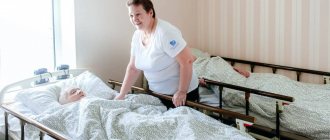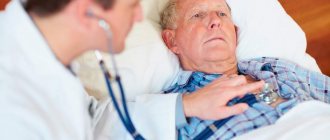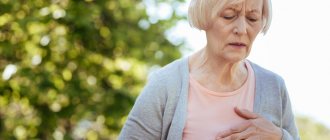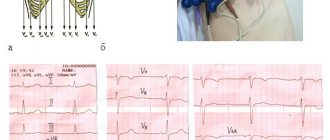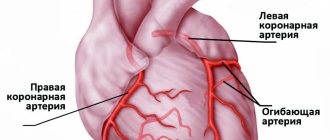Heart attack and stenting
A heart attack is a condition of the human body in which tissue necrosis occurs, which occurs when the supply of blood to parts of the body is disrupted. This pathology can affect not only the heart muscle, but also other organs. It is believed that myocardial infarction is the most dangerous manifestation of the disease.
There are 2 types of heart attack:
- Large-focal . Serious pathology that may result in complete disability;
- Finely focal . A milder disease, after which the functionality of the body can be fully restored.
Important
! If you suspect this pathology, you should immediately consult a doctor in order to receive timely medical or surgical treatment, ensure peace, and increase the chances of a full recovery.
A little more than a century ago, doctors widely recommended abandoning physical activity during rehabilitation after stenting of cardiac vessels.
Patients were prescribed bed rest for two months without the ability to move even around the apartment. However, at the moment the situation has changed dramatically.
Studies have shown that earlier restoration of physical activity promotes a speedy recovery and also reduces the risk of another heart attack.
An inactive lifestyle is an unusual state for human nature. Lack of physical activity leads to serious health problems. And refusal of exercise therapy at the stage of rehabilitation after bypass surgery can cause the formation of blood clots in the arteries, leading to the development of pneumonia and other complications.
People who have had a heart attack often lose their zest for life, become depressed and refuse rehabilitation. A set of physical exercises helps to successfully combat a depressed mood by improving blood circulation and restoring heart function. Small changes and a gradual increase in load give the patient hope for a speedy recovery.
When continuing treatment at home, rehabilitation after hospital plays a huge role. When carrying out this procedure, the patient must adhere to certain rules:
- Change your diet and diet;
- Review your general lifestyle;
- Stop drinking alcohol and quit smoking;
- Constantly resort to therapeutic exercises, which will reduce the likelihood of a recurrence of the attack.
Preparation for coronary angiography
To plan the operation, it is necessary to obtain information about the condition of the coronary arteries and heart function. For this purpose, diagnostic tests are carried out, which in an emergency include an ECG and laboratory diagnostics, and in a planned case, a more detailed examination is necessary.
Examination before elective surgery includes:
- ECG (including Holter monitoring)
- Echocardiography (including with load)
- MSCT coronary angiography or preliminary coronary angiography
- Gastroscopy (EGD)
- X-ray of the lungs
Before surgery, you may be given a loading dose of antithrombotic drugs to avoid early thrombotic complications.
Life after myocardial infarction
Medical statistics from the Russian Federation indicate an increased percentage of mortality from myocardial infarction. More than 40% of cases are provoked by the development of this pathology. However, doctors often manage to save the patient’s life, and then the time after a heart attack is considered a particularly important period.
Stress, nerves, excessive passivity of movements and lack of control over food intake should be completely eliminated. The patient's internal motivation is also of great importance. No doctor's advice or medications will help with the disappearing desire for life.
To avoid a repeat attack, it is imperative to listen to your body.
Important
! Mild muscle pain in the chest, spreading to the shoulder and jaw, informs the patient of excessive anxiety and may be a harbinger of an impending heart attack.
Because of the disease, the usual course of life changes, so loved ones also need to take care of the patient’s emotional peace and compliance with all the doctor’s instructions.
Recovery stages:
| Stage | Title, approximate dates | Location |
| 1 | Stationary (1–10 days) | — Intensive care unit or intensive care unit — Cardiology department |
| 2 | Rehabilitation-inpatient (11–28 days) | — Center for medical or cardiac rehabilitation — Cardiac department in a sanatorium |
| 3 | Outpatient (about 2 months) | — Clinic — Physical education and treatment center — Home |
Where is stenting performed?
At the Center for X-ray Surgical Methods of Diagnostics and Treatment, employees have extensive experience in endovascular treatment of coronary heart disease. Interventions of varying degrees of complexity are carried out: in acute coronary syndrome, on the trunk of the left coronary artery, bifurcation lesions, as well as recanalization of chronic occlusions using the most modern and innovative instruments. During the year, the department performs approximately 1,500 coronary procedures.
The cost of the work can be found here.
We provide quotas for stenting in more detail.
Features of rehabilitation
The choice of rehabilitation tactics after an attack depends entirely on the general condition of the patient and the individual characteristics of the body.
But the most dangerous is the first month of recovery. During this period, the patient should be under the close attention of doctors and relatives.
Therefore, the first stage of rehabilitation after a heart attack takes place directly in the hospital, then the patient is discharged with the condition of mandatory regular visits to the attending physician. When the risk of a recurrent attack is minimized, all that remains is to follow the prescribed regimen.
Medical rehabilitation
Medical or inpatient rehabilitation after a heart attack lasts from a week to a month, depending on the patient’s individual characteristics. While in the clinic, in the absence of contraindications, the patient is prescribed the following series of medications:
- strong narcotic analgesics;
- thrombolytics;
- anticoagulants;
- ACE inhibitors.
This conservative therapy is carried out to maintain cardiac activity and prevent the development of coronary disease. After the acute phase of rehabilitation (bed rest), the patient is prescribed moderate physical activity. At the initial stage, the patient is only recommended to independently turn over on the bed, stretch his limbs a little and sit on the edge of the bed.
At the second stage of the rehabilitation period, medical practice allows you to walk slowly around your own room. And before discharge, physical activity increases, the patient walks along the corridor, flights of stairs and courtyard.
Attention
! Also, while in the clinic, a qualified psychologist conducts conversations with the patient and his relatives. Its task is to strengthen faith in recovery, combat apathy and prepare for rehabilitation outside a medical institution.
At home
For the first time after a myocardial infarction, it is undesirable to carry out rehabilitation at home. Despite the fact that morally being close to your family within the walls of your home gives you strength, carrying out health procedures becomes more troublesome. It is not possible to consistently monitor vital signs.
However, after 3-6 months you can begin the maintenance phase. This stage includes the following clinical recommendations:
- maintaining a balanced diet;
- complete cessation of bad habits, especially smoking;
- inclusion of physical therapy in the exercise regime;
- taking maintenance medications;
- regular visits to your doctor.
Important
!
In the first year of rehabilitation, the risk of another fatal heart attack is 7-10%
. This happens because the patient cannot recognize the attack in time; there are often no symptoms. Therefore, it is extremely important to follow all doctor’s instructions and come to your appointment at the appointed time.
Recovery methods
Basic means of rehabilitation after myocardial infarction:
- drug treatment of circulatory disorders;
- Exercise therapy and physiotherapy;
- psychological support and training at a health school for patients with coronary artery disease;
- Spa treatment.
The doctor develops a recovery program after myocardial infarction individually, taking into account the patient’s condition:
- the extent of the lesion (small focal or transmural infarction can be diagnosed);
- localization of ischemic necrosis (apex, septum, wall are affected);
- presence of concomitant diseases.
Definition of clinical group
There are three clinical groups of patients:
- 1 (mild) – the body responds normally to stress, there are no symptoms of heart failure, conduction and rhythm are preserved;
- 2 (moderate) – against the background of arterial hypertension, drug therapy is required, conduction disturbances, heart failure of the 2nd degree, and a permanent form of atrial fibrillation are diagnosed;
- 3 (severe) – a thrombus is present in the heart cavity, ventricular rhythm disturbances are detected at rest and during exercise, the patient is diagnosed with acute aneurysm and heart failure of 3-4 degrees.
Physical rehabilitation
Recovery is impossible without a gradual and systematic expansion of physical activity. Prolonged bed rest increases the risk of developing congestive pneumonia and thromboembolic complications. Lack of physical activity leads to disruption of the gastrointestinal tract and weakening of muscles. This increases the duration of rehabilitation and negatively affects the quality of life.
Taking into account the type of response, a physical therapy program is selected. The intensity of the load is determined individually. They increase gradually with constant monitoring of all indicators.
Psychological rehabilitation
A heart attack is a disease that requires immediate hospitalization. The need for long-term treatment, fear of death, and restriction of activity lead to serious disturbances in a person’s psychological state. This explains the importance of conducting psychological and psychotherapeutic work with the patient.
In addition to the help of professionals, support from loved ones is also required. This allows you to avoid neurosis and depression, which negatively affect health and adaptive capabilities.
Patients often cease to correctly assess their capabilities. There are two extremes: they are afraid of any physical activity or exceed the permissible limits. Here you also have to work with a psychologist.
Drug therapy
Drug therapy during the rehabilitation period is necessary for:
- blood pressure control;
- prevention of angina pectoris, arrhythmia;
- normalization of lipid metabolism and blood clotting;
- treatment of chronic heart failure.
Main groups of drugs:
- antiarrhythmic - used to prevent disturbances in the rhythm, frequency, and sequence of heart contractions;
- antiplatelet agents - used to prevent thrombosis, reduce the risk of strokes and heart attacks;
- beta-blockers – reduce myocardial oxygen demand;
- hypotensive - they are necessary to normalize blood pressure in hypertension;
- nitro drugs – effective for angina pectoris;
- statins – prevent the formation of atherosclerotic plaques and serve as the prevention of atherosclerosis.
Drug therapy is prescribed by a cardiologist. He monitors the patient’s condition and, if necessary, adjusts the treatment program.
Prevention
Rehabilitation after a heart attack will be incomplete if the patient does not eliminate risk factors. Your lifestyle will have to change. Necessary:
- stop smoking - nicotine negatively affects the inner lining of blood vessels (endothelium), increases cholesterol levels (low-density lipoproteins), causes vasospasm, increases blood pressure;
- minimize alcohol consumption (no more than 30 g for men, 20 g for women) or completely abandon it - alcohol increases blood pressure, causes arrhythmia, tachycardia, has a toxic effect, can provoke a heart attack and death;
- give up unhealthy foods, control your weight (body mass index should be between 25-27 kg/m2).
When preparing your diet, it is necessary to reduce the proportion of animal fats - they contain cholesterol. Smoked meats, canned food, and pickles are excluded. Products are steamed, stewed, baked. Frying is excluded. The basis of the menu after a heart attack:
- sea fish;
- lean meats;
- fruits and vegetables;
- nuts;
- whole grain cereals;
- wholemeal bread;
- dairy products;
- beans, lentils;
- olive oil.
Diet
A diet after a heart attack is prescribed not only for the period of recovery and rehabilitation, but for the rest of your life. In most cases, the patient is recommended to undergo therapeutic diet No. 10 I , which includes three diet options.
The diet can be very varied, but it is necessary to prepare dishes following certain rules:
- It is necessary to significantly reduce the consumption of salt and products containing it. Salt leads to stagnation of fluid in the body, which contributes to the appearance of edema and shortness of breath. The daily norm is assigned to each individual, but on average the amount should not exceed 1 teaspoon per day .
- It is recommended to exclude fatty and fried foods, and also avoid pickles and smoked foods. The best cooking methods are: baking, steaming, boiling.
- The amount of additional fluid per day should not exceed one liter. You should not drink a lot of water after 5 pm. The maximum allowable amount at this time is 250 ml (1 mug).
- Some drinks should be avoided altogether. These include alcohol in any form, coffee and soda. The desired caffeine can be replaced with more gentle chicory.
- It is also necessary to enrich the diet with dried fruits containing potassium and magnesium: dried apricots, raisins, prunes.
The optimal amount of calories per day is 2300 Cal (the female norm is slightly lower, no more than 2000). However, it is important to follow a diet, dividing the total number of calories into 4-7 small meals . Products also need to be selected carefully. The diet must be composed of:
- berries, vegetables and fruits;
- plenty of fresh herbs;
- fermented milk products;
- lean fish (required);
- seafood;
- poultry meat with the addition of vegetable oil, preferably olive;
- lean meats;
- cereal crops.
It is recommended to reduce the amount of sugar and fast carbohydrates consumed as much as possible. There is little benefit to the body, but the harm after surgery may be much greater.
If you are overweight, it is recommended to follow a calorie deficit diet to bring your body weight back to normal. Heavy weight significantly increases the load on the heart muscle.
Recommended products for diet I-III:
- pureed vegetable and cereal soups (during diet III, they can be prepared in light meat broth);
- lean fish;
- veal;
- chicken meat (without fat and skin);
- cereals (semolina, oatmeal, buckwheat and rice);
- steamed egg white omelette;
- fermented milk drinks;
- low-fat sour cream for seasoning soups;
- butter (with a gradual increase in its quantity to 10 g by the third period);
- skim milk for adding to tea and porridge;
- wheat crackers and bread;
- low-fat sour cream for seasoning soups;
- refined vegetable oils;
- vegetables and fruits (initially boiled, then it is possible to introduce raw salads and purees from them);
- rosehip decoction;
- fruit drinks;
- compotes;
- jelly;
- weak tea;
- honey.
It is necessary to exclude foods from the diet:
- fresh bread;
- baking and baked goods;
- fatty meat dishes;
- offal and caviar;
- canned food;
- sausages;
- fatty milk products and whole milk;
- egg yolks;
- barley, pearl barley and millet;
- legumes;
- garlic;
- White cabbage;
- turnips and radishes;
- cucumbers;
- spices and pickles;
- animal fats;
- margarine;
- chocolate;
- grapes and juice from them;
- cocoa and coffee;
- alcoholic drinks.
Coronary artery bypass grafting
It is also a very effective method of treating myocardial infarction. The purpose of this operation is to create a new path for the blood, bypassing the vessel affected by atherosclerosis. For this, a special shunt is used - a part of the patient’s own vessel, taken from the thoracic artery or radial artery of the arm. It is sewn into the narrowed or blocked artery above and below the site of the lesion. Thus, the volume of blood required for heart function is normalized. Doctors are able to restore blood circulation in the affected area of the heart muscle in a short period of time.
The operation eliminates the very cause of the heart attack and is often performed as planned so that the patient can avoid a heart attack. The risk of developing a heart attack after surgery is significantly reduced, and the patient regains ability to work with a normal amount of physical activity.
Coronary artery bypass grafting is a type of open intervention for a beating heart. That is, to carry it out it is necessary to open the chest. There are options for surgery with or without artificial circulation.
Exercise therapy after a heart attack
Physical exercise has undoubted benefits during rehabilitation. Regular exercise helps strengthen the muscle tissue of the heart, normalizes the functioning of the nervous system and relieves depression.
Thanks to moderate loads, scarring of the consequences after a heart attack is accelerated. Also, exercise therapy is necessary if the patient is overweight.
Important
! You cannot independently assign a load level based on your own feelings. The increase should occur gradually under the close supervision of a professional trainer or attending physician.
| Stage | Location | Days | Load volume |
| 1 | Intensive therapy | 1 | Strict bed rest Turning in bed Raising the head of the bed for no more than 10 minutes 1–3 times a day |
| 2–3 | Sit in bed and (or) chair for up to 20 minutes 1-3 times Eat while sitting Start physical therapy classes under the supervision of an instructor for no more than 5 minutes | ||
| 4–7 | Get up and walk next to the bed 2-3 times a day Exercise therapy (physical therapy) up to 10 minutes a day | ||
| Cardiology | 8–10 | Sitting in a chair and/or bed all day Going to the toilet in a wheelchair Walk around the bed and around the ward - gradually increasing the number of minutes Perform physical therapy for 10–15 minutes | |
| From 10 | Leaving the room Increase the load on your well-being, walking from 50 to 500 meters daily, with rest breaks Do therapeutic exercises for up to 20–30 minutes twice a day | ||
| 2 | Cardiac rehabilitation center or sanatorium | 14–28 | Do exercises on cardio equipment (treadmill, bicycle ergometer) with a gradual increase in intensity and time Do moderate walking in the fresh air Perform sets of therapeutic exercises for 40–60 minutes 2 times a day |
| 3 | Home + physical education and treatment center | From 29 | Dosed walks in the fresh air up to 3.5 km 3 times a week, at the initial stage - with rest and at a slow pace Climbing flights of stairs up to the 3rd–5th floor, also with breaks 1–2 times a week (does not replace walking!), starting with a slow step up 1 step in 3–4 s Exercises on exercise machines that train the heart muscle, 20-30 minutes a day (at home or in a specialized center) |
Physical therapy for this pathology leads to the following effects:
- Strengthening the heart muscles;
- Stimulating better blood flow through the vessels;
- Reducing cholesterol;
- Reducing the possibility of developing atherosclerosis;
- Increased ability of the heart to contract;
- Makes blood vessels more elastic;
- Rehabilitation reduces the risk of thrombosis.
Recovery stages
Rehabilitation after myocardial infarction is divided into several gradual stages:
- Surgery for blood clots that need to be removed;
- Achieving the standard of living of patients that was before the disease;
- Diagnosis of the heart and blood vessels, as well as gradual prevention to improve their condition;
- Carrying out therapy with medications;
- Changing the entire lifestyle, including a special diet, exercise, increasing rest time;
- Slow but consistent return to working capacity and normal routine.
Rehabilitation can be carried out not only in clinics and rehabilitation centers, but after discharge from the hospital.
You should start with restoring the physical functions of the body:
- Since after the onset of the pathology the patient was forced to stay in bed for a long time, rehabilitation can begin simply by turning over from one side to the other;
- After 2 days , you are allowed to sit down and relieve yourself while sitting, and the time spent in a sitting position should not exceed 10 minutes ;
- Then the period should be gradually increased, sitting on the bed for up to half an hour;
- The next exercise can be considered trying to get up and walk around the room for a while;
- After a week, you can do a simple warm-up and remain in a sitting position for an unlimited amount of time;
- Next you need to walk up the stairs every day, if possible;
- Then it is allowed and recommended to walk at a leisurely pace. At first, about half a kilometer a day, gradually increasing the distance to 1500 meters , and you need to walk along a road that does not have differences in altitude.
You can use the table below to understand when and what you can do.
| Degree | Sick day | Mode | Permitted loads |
| 1A | 1st | Strict bed | The patient is in a supine position. Special exercises from exercise therapy are prohibited. He can only turn on his right side and eat food on his own. |
| 1B – 2A | From 2nd to 3rd | Bed extended | The patient can independently turn and sit up in bed, initially with the help of medical staff, and then independently. Later you can move to a chair. Exercises are allowed in a supine position, which are performed for 8-10 minutes. Breathing should be static. After each exercise you need to take a break. The pulse should not exceed 20 beats per minute. |
| 2B – 3A | From 4th to 14th | Ward strict | The patient can already walk around the ward and corridor at a distance of 20 to 200 m. Exercises performed in a sitting position are already allowed. The pace is slow or medium. |
| 3B | From 14th to 21st | Ward extended | The patient is already allowed to walk along the corridor without restrictions. Exercises are performed in standing and sitting positions, and can be either individual or group. |
| 4A and 4B (classes I, II, III and IV) | From the 21st | Free | Walking is acceptable, and the step speed is average - from 70 to 100 steps per minute. A set of exercises is performed in a sitting and standing position. |
Contraindications and restrictions
Contraindications for exercise therapy during rehabilitation after stenting of the coronary arteries are calculated individually for each patient, which are divided into 4 classes :
- Patients with pathologies of the heart muscle, but who do not require special restrictions. During the usual pace of life and activity, fatigue and shortness of breath do not appear. Therefore, they are recommended to: run, briskly walk, climb stairs and lift weights up to 15 kg .
- Patients with minor limitations in physical activity. In patients of this class, there is no change in parameters in a calm state, but slight dizziness and rapid heartbeat appear. Therefore, a special lightweight program is being developed: moderate running, walking at an average pace, lifting weights up to 10 kg and walking up the stairs to a maximum of the 5th floor .
- The condition is assessed as satisfactory, but gymnastics is permissible in a reduced amount, since the condition sharply worsens when moving. It is allowed to walk up to 90-120 steps per minute, climb stairs to the 3rd floor and carry no more than 3 kg .
- The load during rehabilitation after stenting of the carotid artery is minimized. Patients are allowed to walk at a slow, measured pace, stopping frequently to catch their breath.
Therapeutic exercises have a unique value during recovery. However, how long the rehabilitation period will take depends on compliance with all the doctor’s recommendations. But there are also a number of strict prohibitions on exercise therapy:
- fever;
- negative change in ECG indicators;
- cardiogenic shock;
- intense pain in the heart muscle;
- heart rhythm disturbances resistant to drug therapy;
- swelling of the lung tissue, pneumonia;
- poor blood circulation and increased heart rate at rest (more than 105 beats per minute).
Other indicators not related to the surgery should also be taken into account when determining prohibitions. For example, brain problems or other head injuries are one of the most serious contraindications to exercise therapy during rehabilitation after cardiac stenting.
Rehabilitation after a planned awning requires time and patience. The vessels are still weak and there is a high risk of a second attack, so doctors’ prohibitions must be taken seriously!
There are a number of contraindications to physical activity after a heart attack. These include serious heart complications:
- cardiac aneurysm;
- arrhythmia;
- heart failure.
The main contraindication is excessive physical and mental stress on the heart and the entire body as a whole. The patient needs to be kept at rest and in a supine position.
When doing gymnastics, you may experience shortness of breath, wheezing, mild heart pain and panic attacks. If your readings are normal, you should not be alarmed by these symptoms. But to be sure, you definitely need to track:
- heart rate;
- arterial pressure;
- ECG.
Attention
! If there is shortness of breath, it is necessary to keep the patient elevated so that the person does not suffocate.
It is undesirable to work in garden plots for a long time after an attack, especially in hot weather, in order to prevent overload of the heart muscle.
If the patient has heart failure or is in a state of shock, then he cannot be transported over long distances.
You need to be careful when taking medications; they should only be prescribed by a doctor, after having done all the tests and examined the patient first.
Physical therapy, including intense exercise, is also contraindicated during a heart attack. Rehabilitation is prohibited when the presence of arrhythmia, high body temperature, more than 38 degrees , as well as low blood pressure and heart failure are detected.
After discharge from the hospital, gradual additional rehabilitation is simply necessary to more quickly restore the functionality of the body and return to a normal lifestyle.
There are practically no contraindications for exercise therapy in the event of a myocardial infarction; you just need to follow simple recommendations:
- During an exacerbation of the disease, it is prohibited to perform actions that cause physical activity;
- After at least 72 hours , you must obtain a doctor's permission to conduct classes.
If negative symptoms are detected, as well as due to the unpredictability of the consequences, you should immediately and without hesitation call an ambulance.
Exercise therapy rules
When prescribing exercise therapy, you should follow all the recommendations of the treating doctor:
- There is no need to increase the amount of active actions, even if you feel great;
- It is necessary to stop exercising if you feel worse after exercise. If after some time there is no improvement, then the use of medications is suggested for the normal operation of the product;
- Exercise therapy is used only after meals. But it is not recommended to perform tasks immediately after eating, so as not to overload the body! It is recommended to perform exercises 3-4 hours after eating.
- To prevent a rush of blood to the head, you should not bend below the level of your heart;
- Do not use force.
Complex No. 1
There are several particularly effective exercises that affect the condition during rehabilitation after a heart attack. Each of them starts with a standard position of hands, feet shoulder-width apart:
- You need to raise your arms above your head with your palms facing you, taking a deep breath, stretch and on a long exhale you need to lower your arms. Five to fifteen repetitions are required.
- You should place your hands on your hips and make up to seven turns of your torso. It is important not to lift your feet off the floor.
- The previous exercise can also be performed with your arms out to the side.
- It is necessary to bend back and forth without bending your knees. You should not bend over extremely deeply.
- It is recommended to do squats with your hands on your hips. At first, you can squat while leaning on a wall or chair.
- Leg stretching exercises will also be helpful. First, knees to arms bent 90 degrees. Then toes towards outstretched palms.
It is also recommended to start and end workouts by walking in place to warm up during rehabilitation. Classes must be held regularly at the same time, the duration of which should be from 30 minutes to 1 hour .
Complex No. 2
You can see examples of exercises below.
Important
! You should consult your physician before performing any exercise!
Complex No. 3
Complex No. 4
- In a standing position, the patient places his feet shoulder-width apart, while he extends his arms along the body. Having taken the correct position, you need to point your arms up and pull yourself up, while inhaling. At the next stage, the person exhales, lowering his arms and describing a circle. The number of repetitions is from 4 to 6 times .
- The next exercise is also performed standing. The toes should be spread apart and the hands should be placed on the belt. Next, you need to turn to the left and spread your arms to the sides while inhaling. Afterwards, exhale returning to the original position. In the same way, you need to make the required number of approaches by turning to the right. The number of repetitions is from 4 to 6 times .
- Having taken a vertical position, the arms are fixed along the body, and the legs are placed shoulder width apart. Inhalation is performed. Then the person squats and bends forward slightly, moving his arms in the opposite direction and exhaling. The number of repetitions is from 4 to 6 times .
- The patient is in the same starting position as in the previous exercise. Exhales deeply, the person places his hands on the thighs and squats. Then, when returning to the original position, inhale. The number of repetitions is from 3 to 4 times .
- The patient will need a chair. He should sit down leaning on the back, grab the seat and stretch his legs - this is the starting position. Next, you will need to bend your head back and inhale. Afterwards, return to the previous position by exhaling. The number of repetitions is from 3 to 4 times .
Complex No. 5
Complex No. 6
- Breathing using the diaphragm (see below). Apply 4 times;
- Sharp clenching and unclenching of fingers into a fist. Apply 10 times for both hands;
- Perform rotational movements for each of the feet. Apply 5 times;
- Bend the arms at the elbow joint. Apply 4 times for each hand;
- Raising the pelvis. The exercise is done with an assistant. Apply 3 times;
- This is followed by a short break necessary to restore breathing and heart rate;
- For the next exercise, you need to bend your legs at the knee joint, while your feet should remain on the bed. The patient slowly brings and spreads his knees. Apply 5 times;
- The outstretched arm is first slowly moved to the side, and then returned to the starting position. Apply 4 times for each hand.
- With the support of an assistant, turns on your side in each direction are performed. Apply 3 times;
- Rotation of the hands. Apply 5 times.
Complex No. 7
It is recommended to do a short warm-up before gymnastics in the form of 5-10 minutes of walking in place. This will protect you from sprains and other possible injuries. It also strengthens the blood vessels of the lower extremities.
- Walk in place for 10 minutes .
- You need to sit on a chair without leaning on the back, your posture is straight. Bring your legs together, arms down. Alternately raise your arms up as you inhale, and lower them again as you exhale. Repeat the exercise 5 times .
- Press your hands to your shoulders, raise them slightly above your chest and make parallel circular movements. First, it takes 5 times in a circular arrow, then the same number against it.
- Connect your legs, spread your arms to the sides. As you inhale, pull your knee as close to your chest as possible, helping with your hands. As you exhale, smoothly return to the starting position. Perform 3 to 5 repetitions with each leg.
- Next, you should stand with your feet shoulder-width apart and your arms outstretched. As you inhale, you need to raise your arms up and, bending over, try to reach your toes with your fingers. As you exhale, return to the starting position.
- Place your hands on your waist and perform side bends, 5 times in each direction.
- Standing, feet together, hands at your sides. As you inhale, move your right arm and leg to the side and hold it there for a few seconds. As you exhale, gently lower your limbs. If possible, repeat up to 5 times on each side.
- Walk in place for 15-30 minutes .
Complex sitting
Complex for bedridden patients
Often, with severe lesions, it is necessary to perform exercise therapy for permanently bedridden patients. The set of actions includes the following procedures:
- You need to clench and straighten your fist about 10 times;
- Make circular movements with your feet;
- Bend your legs and arms at the elbows;
- A more complex exercise, performed only with the help of a specialist.
Finger exercises
Doctors often do not prohibit doing finger exercises. Example exercises could be:
Additional exercises
Each specialist uses his own gymnastic technique and set of exercises to train the body after myocardial infarction. Let's consider one of them:
- Standing, spread your legs to shoulder level. Then raise your hands and take a deep breath. As you exhale, lower your limbs in an arc. Repeat 5 times;
- Place your hands on your waist and place your heels together. Turn in different directions, periodically changing inhalation to exhalation. The number of approaches is also 5 times;
- Your arms should be extended along your body, your feet should be shoulder-width apart. Inhale and squat, leaning forward and exhaling.
- Exercise using a chair. You need to sit on it, grab the seats with your hands and straighten your legs. To relax, it is recommended to bend over and throw your head back.
Is it possible to fly on an airplane after stenting?
If stenting was performed as planned, without previous heart attacks, and in the case of stenting with a myocardial infarction, enough time has passed and the patient has fully recovered, then there are no absolute contraindications to air travel.
In any case, in the process of planning a trip with air travel, the patient must consult with his doctor, undergo the necessary examinations and receive recommendations regarding taking medications before and during air travel.
According to the recommendations of the American Heart Association, air travel is contraindicated in the following situations:
- if less than 6 months have passed since a severe heart attack, and two weeks after an uncomplicated heart attack;
- if a person has manifestations of heart failure that cannot be corrected with medications;
- for severe arrhythmias;
- with persistent arterial hypertension;
- if the patient has unstable angina.
Breathing exercises
During the recovery period after myocardial infarction, the use of breathing exercises is of great importance. This method of treatment should not be underestimated, because a carefully selected load has a positive effect on the healing process and facilitates rehabilitation.
Breathing and using the diaphragm:
At the same time, experts warn that you should not get too carried away with such activities, since the wrong approach to therapy can cause considerable harm to the body, provoke an increase in blood pressure and lead to overload of the joints.
There are specially created sets of exercises for patients who have had a heart attack. These activities enrich the heart and blood vessels with oxygen, and also bring the desired relief to a person.
There are two most common methods that help everyone:
- Strelnikova’s gymnastics , performed for both adults and children. The exercise is very simple, you need to take 1500 deep breaths in the morning before eating, or in the evening to get rid of fatigue. Carrying out these actions will help improve memory, improve mood and overall tone of the body.
- Gymnastics according to Buteyko . The procedure involves holding your breath until you can’t get enough air. In this case, inhalations will occur more often and not deeply, which contributes to an increase in carbon dioxide, and therefore the bronchi and vessels through which blood moves expand.
All exercises must be performed only under the supervision of the attending physician, then exercise therapy will only have a positive effect on the patient’s body after a myocardial infarction.
Infusion therapy
Drug drips are an integral part of treatment for symptoms of myocardial infarction. In particular, with this disease, ventricular tachycardia may occur, for which infusion solutions are indicated. In some cases, the Bezold-Jarisch reflex occurs in the myocardium, which is also suppressed by drugs administered through IVs. Anticoagulants and antiarrhythmic drugs are also administered. The method allows drugs to be distributed throughout the vascular system in the shortest possible time.
Condition assessment
After carrying out exercises and various activities, a number of parameters are assessed:
| Index | Change |
| General state | Moderate fatigue Severe fatigue that does not go away for a long time |
| Angina pain | No Moderate, goes away on its own Severe, require medicinal correction |
| HELL | The increase for the upper one is no more than 40 mm Hg. Art., lower - no more than 12 Or a decrease in indicators of no more than 10 units |
| Heart rate | Increase by no more than 20 per minute or decrease by 10 units maximum |
| Breathing problems | An increase of no more than 6 per minute is acceptable. |
| Changes on the cardiogram | Signs of impaired blood flow (decreased ST segment) Violation of the rhythm of contractions Blockade of impulse conduction |
How is stenting performed?
Stenting is a minimally invasive operation that is performed under local anesthesia in the cath lab.
Through puncture of the radial artery in the arm (in most cases) or the femoral artery, the coronary artery is catheterized with a special guiding catheter.
Then a stent is delivered to the area of the coronary artery narrowed by the atherosclerotic plaque through a guidewire. A stent is a metal frame in the form of a compressed tube, placed on a balloon. The balloon is inflated and removed, and the stent remains in the artery as a scaffold, thereby leaving the artery lumen free for blood flow.
Where to undergo recovery: list of centers and institutions
In Russia there are many resorts and health centers specializing in cardiac pathologies. The choice of the necessary institution is carried out depending on concomitant diseases, geographic location and financial capabilities of the patient.
The most popular cardiac rehabilitation centers in the country:
- Kislovodsk (Stavropol Territory) is a balneoclimatic resort from the group of Caucasian mineral waters;
- sanatorium named after Kirov (Crimea);
- rehabilitation center named after. Herzen (Moscow region);
- sanatorium "Zvezdny" (Krasnodar region), which also treats patients with pathologies of the respiratory system, digestion, kidneys, and skin;
- rehabilitation center of the clinic named after. N.I. Pirogova deals with seriously ill patients after a heart attack and complex operations on blood vessels and the heart;
- sanatorium "Electra" (Irkutsk);
- sanatorium-preventorium "Salyn" (Bryansk region).
It is necessary to select an institution for rehabilitation among proven, certified sanatoriums that offer specialized medical services.
Symptoms of the disease
The main symptom is acute chest pain that does not go away after taking nitroglycerin. It occurs suddenly and gets worse quickly. The attack may be accompanied by shortness of breath, cough, and arrhythmia. If the pain lasts more than 15 minutes, you must call an ambulance. The sooner the blood supply to the heart is restored, the smaller the size of the dead area will be.
In a third of patients, myocardial infarction occurs in an atypical form, which significantly complicates early diagnosis and leads to the loss of precious time. Experienced caregivers know about this and can predict the development of an attack based on indirect symptoms. Patients with diabetes may not feel pain. In women, it is often localized in the arm or neck and is accompanied by fatigue. Atypical forms of heart attack also appear:
- pain in the abdomen, throat, lower jaw;
- nausea;
- dizziness;
- confusion;
- cold sweat;
- swelling;
- a sharp decrease in blood pressure.
In many cases, the only symptom of a heart attack is sudden cardiac arrest. In such cases, only urgent resuscitation measures can save the patient.
A delay in treatment of myocardial infarction can cause complications such as:
- cardiogenic shock,
- acute and chronic heart failure,
- arrhythmia,
- arterial hypotension,
- heart aneurysm.
If you suspect an attack, the patient must first be seated and removed from constricting clothing. Then you need to measure his pressure, give crushed aspirin or nitroglycerin (for high blood pressure) and call an ambulance. The services of a nurse significantly increase the chances of patients undergoing surgical treatment. Regular care after a heart attack reduces the likelihood of a recurrence.

